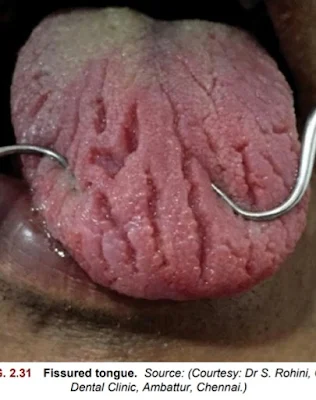Welcome to Dentoword:
Learn your dental terms with detailed explanation
Today's word is "Tongue"
Tongue : 'The Crucial Organ Of Speech & Taste'
What is the Tongue ?
The tongue is a muscular organ situated in the floor of the mouth. It is associated with the functions of taste, speech, chewing, swallowing (deglutition), and cleansing of the mouth. The tongue is composed of skeletal muscles, which are voluntary.
Parts of the Tongue :
- The tongue consists of the root, tip, and body.
- The body has a dorsal surface and an inferior surface.
- The dorsum is divided into oral and pharyngeal parts by a V-shaped sulcus terminalis.
Anatomy of the Tongue :
1. Muscles:- Intrinsic Muscles: These muscles alter the shape of the tongue.
- Extrinsic Muscles: These muscles control its position.
2. Papillae:
- These are projections of the mucous membrane that occupy the anterior two-thirds of the tongue and contain taste buds, which help to detect taste.
- There are the following types of papillae: circumvallate papillae, fungiform, foliate, and filiform.
3. Frenulum Linguae:
A small fold of tissue that anchors the tongue to the floor of the mouth.
Functions of the Tongue:
- Taste: The tongue is covered with taste buds that help detect different flavors.
- Speech: The tongue plays a critical role in articulating words and sounds.
- Chewing: It helps in moving food around the mouth and positioning it between the teeth.
- Swallowing: The tongue pushes the food towards the throat for swallowing.
- Cleansing: It helps in cleaning the mouth by removing food particles and bacteria.
Developmental Disturbances Of Tongue :
A. Aglossia and Microglossia Syndrome:
Aglossia syndrome involves microglossia with extreme glossoptosis. In simple terms, it is a small, underdeveloped tongue. This condition is caused by fetal cell trauma during the first week of pregnancy.
B. Macroglossia (Enlarged Tongue) :
Macroglossia refers to an enlarged tongue, which may be caused by the dilation of lymphatics, muscle hypertrophy, or inflammation.
The inferior surface of the tongue is fused to the floor of the mouth, restricting the free movement of the tongue due to a short lingual frenulum.
Grooves that vary in depth are present along the dorsal and lateral surfaces of the tongue.
E. Median rhomboid glossitis :
It is a focal area susceptible to recurring or chronic atrophic candidiasis.
F. Benign migratory glossitis (geographic tongue) :
It is characterized by a constantly changing pattern of serpiginous white lines surrounding areas of smooth, depapillated mucosa.
G. Black hairy tongue (lingua nigra) :
It is a condition of defective desquamation of the filiform papillae on the dorsal surface of the tongue, usually due to a lack of mechanical stimulation and debridement.
Personal Insight :
During my clinical practice, I encountered many cases of tongue problems that affected patients' quality of life. These issues impacted speech, taste, and oral hygiene, often leading to bacterial infections and systemic problems. Most people clean their teeth but are unaware that cleaning the tongue is also an essential part of daily oral hygiene. In our college's periodontology department, we provide oral hygiene tips to patients after scaling. I observed that most patients do not know how to clean their tongues or what tools to use. Without regular tongue cleaning, bacterial and fungal growth can occur, leading to dental caries, oral candidiasis, and systemic diseases. Therefore, tongue cleaning is just as important as teeth cleaning.
Care and Maintenance for a Healthy Tongue:
1. Cleaning the Tongue:
Use a tongue cleaner or scraper to gently clean the surface of your tongue. This helps remove bacteria, food particles, and dead cells. Here is a helpful video on how to properly clean your tongue :
2. Regular Dental Check-ups: Visit your dentist regularly to help diagnose any oral health issues as early as possible.
3. Stay Hydrated:
Drink plenty of water to keep your oral cavity and tongue moist.
4. Eat a Balanced Diet:
Include a variety of foods rich in minerals and vitamins to support your overall health.
Conclusion:
The tongue is one of the most mobile and useful organs in our body. People often overlook its hygiene despite using it every day to taste various delicious foods. Proper care and maintenance of the tongue are essential to prevent various health problems. By understanding the importance of the tongue and practicing good oral hygiene habits, we can ensure its health and well-being for a lifetime, allowing us to enjoy the perfect taste of food.
Request to Readers:
It's high time to start cleaning your tongue if you haven't been doing so already. Start today! If you have any questions, please let me know in the comment section.Thank you.
References :
1. Shafer's Textbook of Oral Pathology,B Sivapathasundharam
Elsevier Health Sciences -9th edition(2020)
2. Image credit: www.adobestockphoto.com.










No comments:
Post a Comment